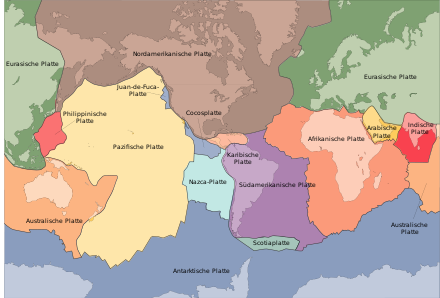Antarctic plate

The Antarctic Plate is one of the largest continental plates (or tectonic plates) on earth. It consists for the most part of continental (ie granite-containing, "light") crustal rock, but also has a small proportion of heavy oceanic (basalt-containing) crust.
Location and demarcation
The Antarctic Plate extends under the entire Antarctic continent and the surrounding Southern Ocean ( Southern Ocean ), and extends partially into the southern areas of the Pacific and Indian Oceans . It occupies the entire south side of our planet. The Antarctic Plate is bordered to the north (clockwise) by the South American Plate , the African Plate , the Australian Plate , the Pacific Plate and the Nazca Plate . There may be a few other smaller plates in the transition zones to the large neighboring plates; its existence has not yet been clarified beyond doubt.
Tectonic activity
In the course of plate tectonics, the Antarctic plate moves at an absolute speed of around 2 cm per year. Since all other tectonic plates on earth are also in constant motion, their relative speed is usually lower; it amounts to z. B. based on the Pacific plate a good one centimeter per year. However, this is only a general mean; In isolated cases, significantly larger annual movements can occur at the plate boundaries, since the movement of the Antarctic plate - and all others - is not linear, but rather rotating due to the spherical shape of the earth.
In contrast to many other large continental plates, the Antarctic plate has only submarine boundaries to its neighboring plates. The phenomenon of sea-floor spreading occurs over large stretches, most notably at the transitions between the Pacific and Australian plates .
See also
literature
- Paul Fitzgerald: Tectonics and landscape evolution of the Antarctic plate since the breakup of Gondwana, with an emphasis on the West Antarctic Rift System and the Transantarctic Mountains . In: Royal Society of New Zealand. Bulletin . tape 35 , 2002, ISSN 0370-6559 , p. 453-469 .
- Peter Giese (Ed.): Oceans and Continents . Spectrum of Science Verlag, Heidelberg 1987, ISBN 3-922508-24-3 , p. 1-248 .